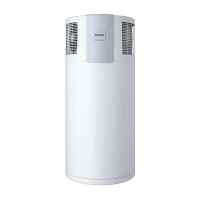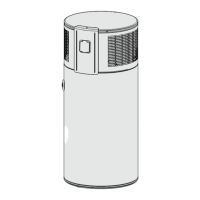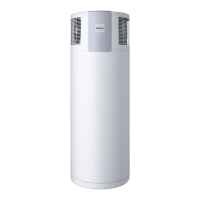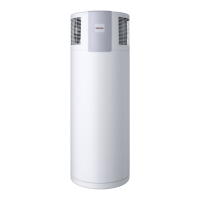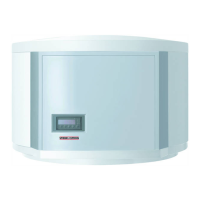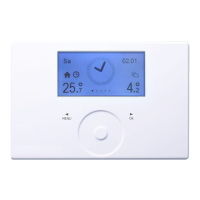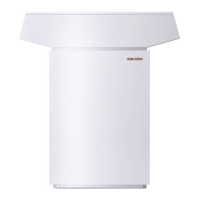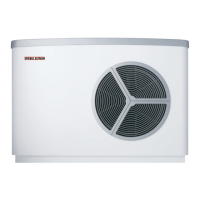14 | WWK222-302 H www.stiebel-eltron.com
INSTALLATION
Installation
Safety valve (cold water expansion control valve, 550 kPa)
If specified, install a type-tested 550 kPa safety valve (expan-
sion control valve) in the cold water supply line.
The safety valve protects the appliance against unacceptable ex-
cess pressure. The diameter of the cold water supply line must be
no greater than the diameter of the safety valve.
Ensure that the expansion water escaping from the safety
valve can drip into a drain, e.g. a tank or funnel.
Ensure the drain cannot be shut off.
Size the drain so that water can drain off unimpeded when
the safety valve is fully opened.
Ensure that the discharge pipe of the safety valve is open to
atmosphere.
Fit the discharge pipe of the safety valve with a constant
downward slope and in a room free from the risk of frost.
10.1.2 Pressure reducing valve
The maximum pressure in the cold water supply line must be at
least 20% below the response pressure of the lowest pressure
rated valve installed, otherwise a pressure reduction valve will be
required. If this is the case, install a pressure reduction valve in
the cold water feed. The pressure reducing valve must be set to
440 kPa if a safety valve is installed; otherwise to 550 kPa.
10.1.3 Drain valve
Install a suitable drain valve at the lowest point in the cold
water inlet line.
10.1.4 Thermal insulation
Insulate the DHW line and valves against heat loss and to im-
prove energy efficiency in accordance with locally applicable
regulations.
Insulate the cold water supply line to prevent condensate
forming.
10.1.5 DHW outlet
WARNING Burns
The water in the DHW cylinder can be heated to temper-
atures in excess of 60°C. There is a risk of scalding at
outlet temperatures in excess of 43 °C.
In Australia and New Zealand, observe regulations in
accordance with AS/NZS3500.4:
Install a tempering device in all systems intended
for personal hygiene.
10.2 Condensate drain
Install a condensate drain hose in order to remove the condensate
which forms.
Connect the condensate drain bend included in the standard
delivery to the condensate drain connection.
Connect a condensate drain hose to the condensate drain
bend.
!
Material losses
Ensure condensate cannot back up.
Use a condensate drain hose with a diameter great-
er than the diameter of the condensate drain bend.
Ensure the condensate drain hose is not kinked.
Route the condensate drain hose with a continuous
fall.
The condensate drain must be open to atmosphere.
Use a suitable condensate pump if there is insufficient fall.
Observe the building characteristics.
Condensate pan heater
!
Material losses
If the temperature at the installation site could continu-
ously fall below freezing (1-2 days) you should install
a condensate pan heater. The condensate pan heater is
not part of the standard delivery.
When the compressor is running, install a load-dependent relay
to switch on the condensate pan heater after a delay.
The condensate pan heater must have an external power supply.
10.3 Power supply
WARNING Electrocution
The connection to the power supply must be in the form
of a permanent connection. Ensure the appliance can
be separated from the power supply by an isolator that
disconnects all poles with at least 3mm contact sepa-
ration. Contactors, mains isolators or fuses can be used
for this. This type of isolator must be installed in the
fixed electrical installation according to the regulations.
For Australia: Ensure the appliance can be separated
from the power supply by a suitable isolator. Contac-
tors, circuit breakers or fuses can be used for this. This
type of isolator must be installed in accordance with the
wiring rules.
WARNING Electrocution
Carry out all electrical connection and installation work
in accordance with national and regional regulations.
WARNING Electrocution
Ensure that the appliance is earthed.
WARNING Electrocution
Observe the safety measures to prevent contact with
dangerous 'live' currents.
WARNING Electrocution
Coming into contact with 'live' components presents a
threat to life. Disconnect the appliance from the power
supply before carrying out work inside the appliance.
Prevent the power supply from being switched on while
you are working on the system.
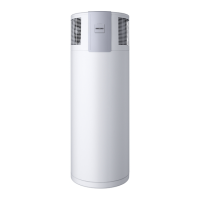
